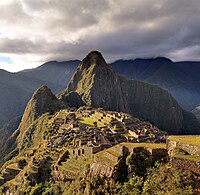
Back Curaca Spanish Kuraka Basque Kuraka French Курака Macedonian Curaca (Incaleider) Dutch Курака Russian Курака Ukrainian 库拉卡 Chinese
 |
| Inca Empire |
|---|
| Inca society |
| Inca history |
A kuraka (Quechua for the principal governor of a province or a communal authority in the Tawantinsuyu[1][2]), or curaca (Hispanicized spelling[3]), was an official of the andean civilizations, unified by the Inca Empire in 1438, who held the role of magistrate, on several hierarchical levels, from the Sapa Inca at the head of the Empire to local family units.[4]
The kurakas were the heads of the ayllus (clan-like family units) and of federations of ayllus, called chiefdoms or curacazgos.[5] During the Inca Empire, the Sapa Inca governed with the help of the existing local hierarchies.[5] They served as tax collector, and held religious authority, in that they mediated between the supernatural sphere and the mortal realm. They were responsible for making sure the spirit world blessed the mortal one with prosperity, and were held accountable should disaster strike, such as a drought.[6] Kurakas enjoyed privileges such as being exempt from taxation, the right to polygamy and to ride in a litter.[4]
The kuraka was an aristocrat who frequently, but not always, descended from the previous generation.[7] Kuraka means 'superior' or 'principal', and his authority was granted by the Inca.[8] Each ayllu and chiefdom had four kurakas: two of them ruled the upper and lower (hanan and hurin) parts, and each of these had an assistant. However, of the four, one kuraka was superior to the rest.[9]
With the conquest of Peru by the Spanish, the Spanish system of rule utilized indigenous leaders as mediators to mobilize labor and tribute from their communities for delivery to Spaniards awarded those benefits in encomienda. The system was implemented first in the Caribbean islands, where such leaders were called caciques, then Mexico, where the Arawak term cacique was extended, and then in the Andean region, where the term kuraka persisted. Indigenous elites maintained their positions so long as they played their assigned role. In the late eighteenth century, the increased taxation of indigenous put pressure on kurakas' allegiances to their own communities and their desire to maintain their status in the colonial order. The 1781 Tupac Amaru rebellion, led by a kuraka, José Gabriel Condorcanqui, known as Tupac Amaru II, was the most serious challenge to the Spanish colonial order in the Andes since the Spanish conquest.
- ^ Teofilo Laime Ajacopa, Diccionario Bilingüe Iskay simipi yuyayk'ancha, La Paz, 2007 (Quechua-Spanish dictionary)
- ^ Diccionario Quechua - Español - Quechua, Academía Mayor de la Lengua Quechua, Gobierno Regional Cusco, Cusco 2005 (Quechua-Spanish dictionary)
- ^ Puerto Rico. Office of Historian (1949). Tesauro de datos historicos: indice compendioso de la literatura histórica de Puerto Rico, incluyendo algunos datos inéditos, periodísticos y cartográficos (in Spanish). Impr. del Gobierno de Puerto Rico. p. 306. Retrieved 4 January 2020.
- ^ a b Incas: lords of gold and glory. New York: Time-Life Books. 1992. pp. 61. ISBN 0-8094-9870-7.
- ^ a b Itier, César (2008). Les incas (in French). Paris: Les Belles Lettres. pp. 69–71.
- ^ Ramírez, Susan E. (2005). To feed and be fed: the cosmological bases of authority and identity in the Andes. Stanford, Calif: Stanford University Press. p. 135. ISBN 0-8047-4922-1.
- ^ Timothy K. Earle and Allen W. Johnson, The evolution of human societies: from foraging group to agrarian state Stanford: Stanford University Press 1987, p.263
- ^ Jean-Jacques Decoster; Pedro Sarmiento de Gamboa; Sarmiento de Gamboa, Pedro; Vania Smith; Bauer, Brian S. (2007). The history of the Incas. Austin: University of Texas Press. pp. 146, 147. ISBN 978-0-292-71485-4.
- ^ McEwan, Gordon Francis (26 August 2008). The Incas: New Perspectives. W. W. Norton. pp. 96–98. ISBN 978-0-393-33301-5.